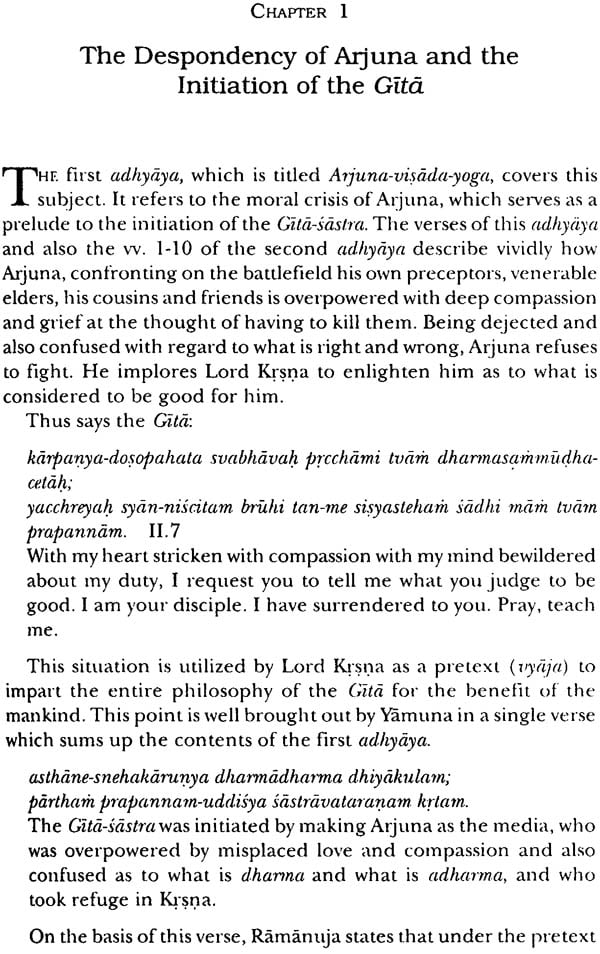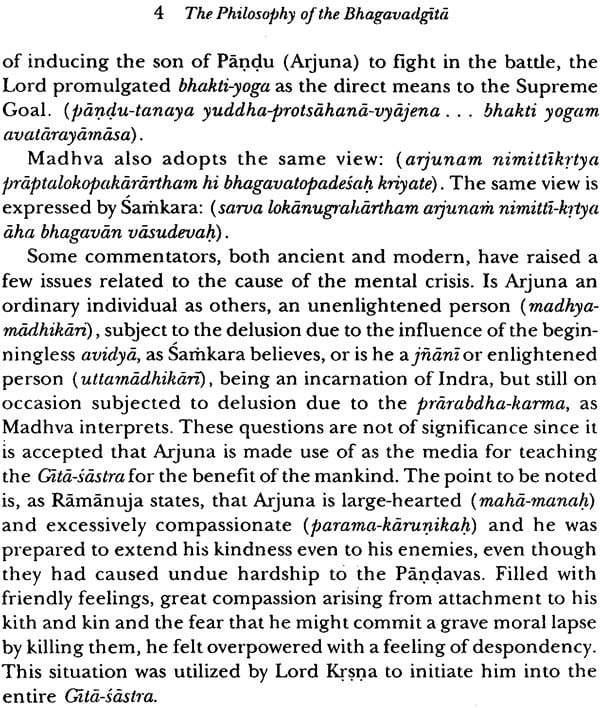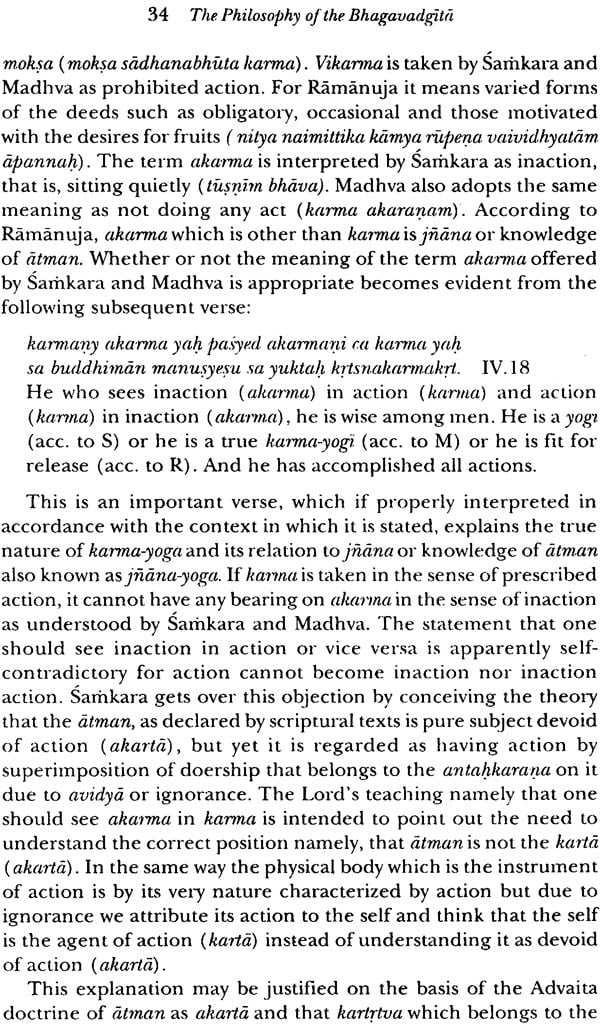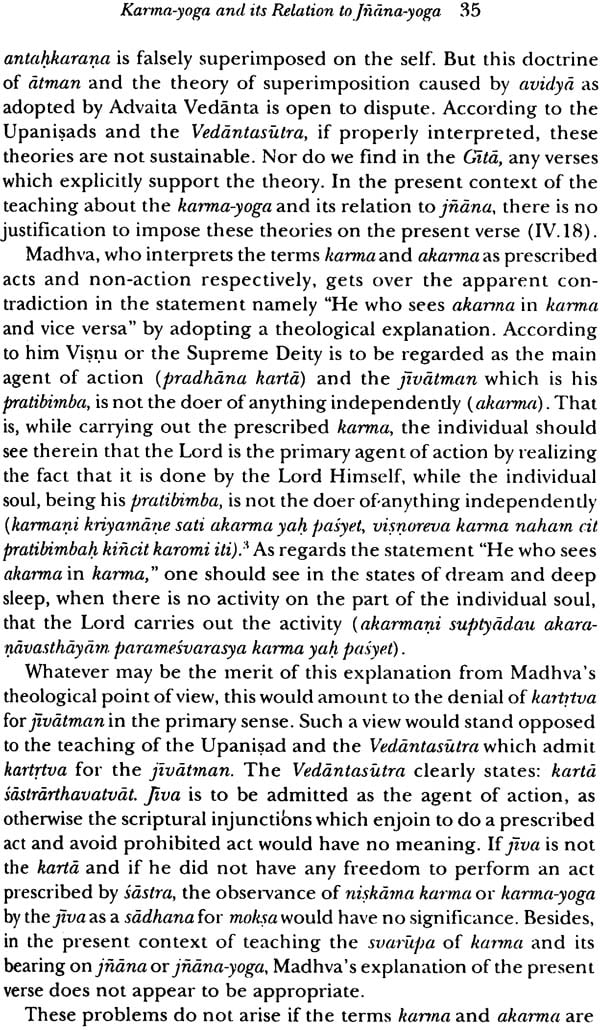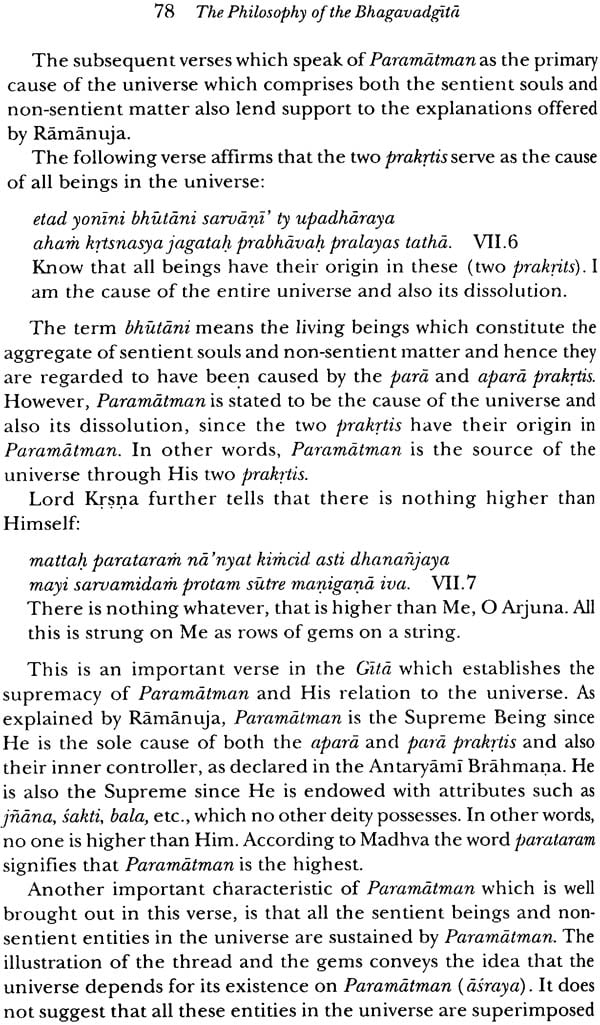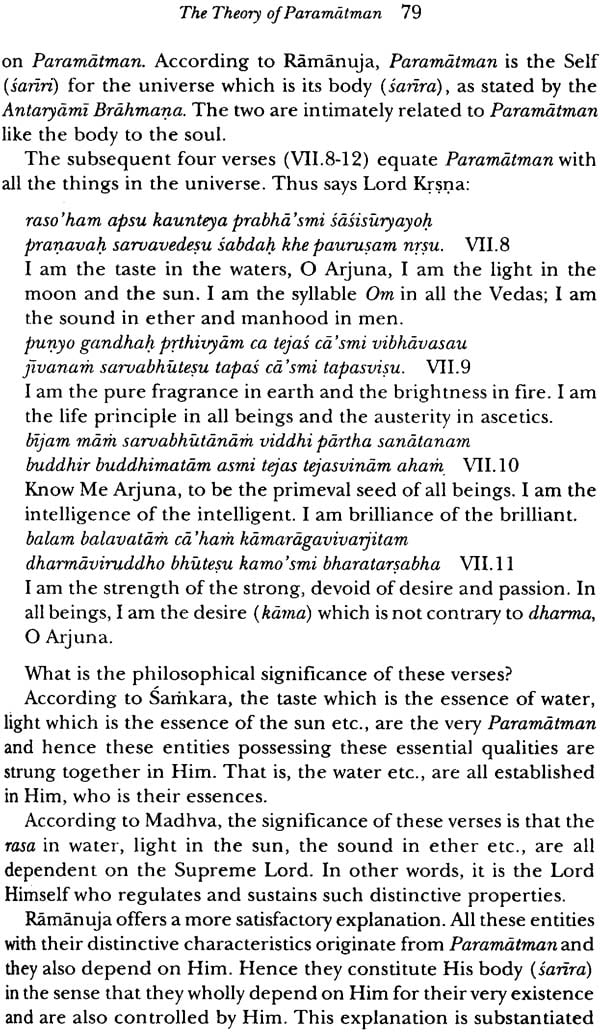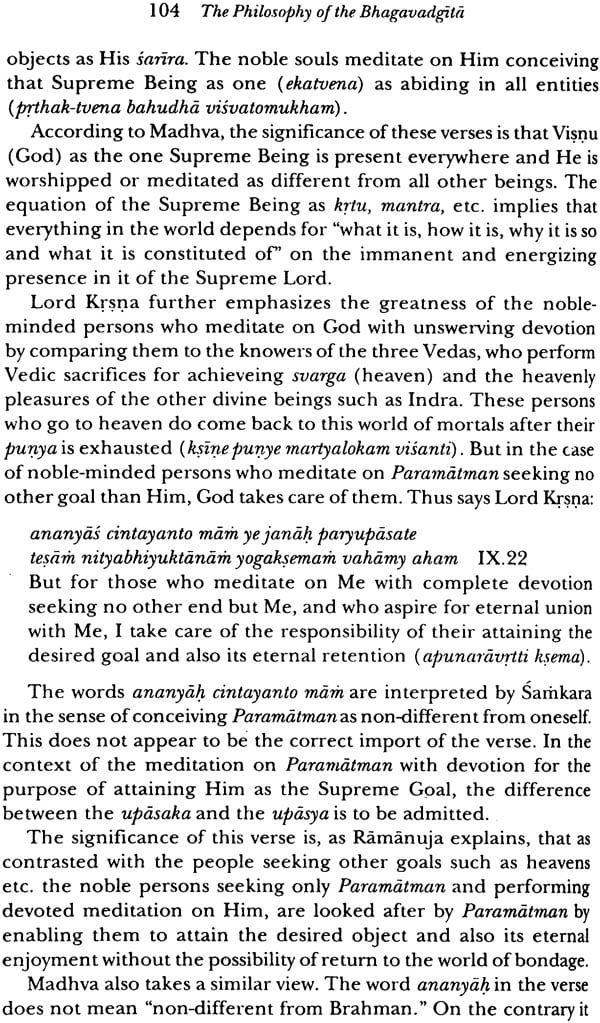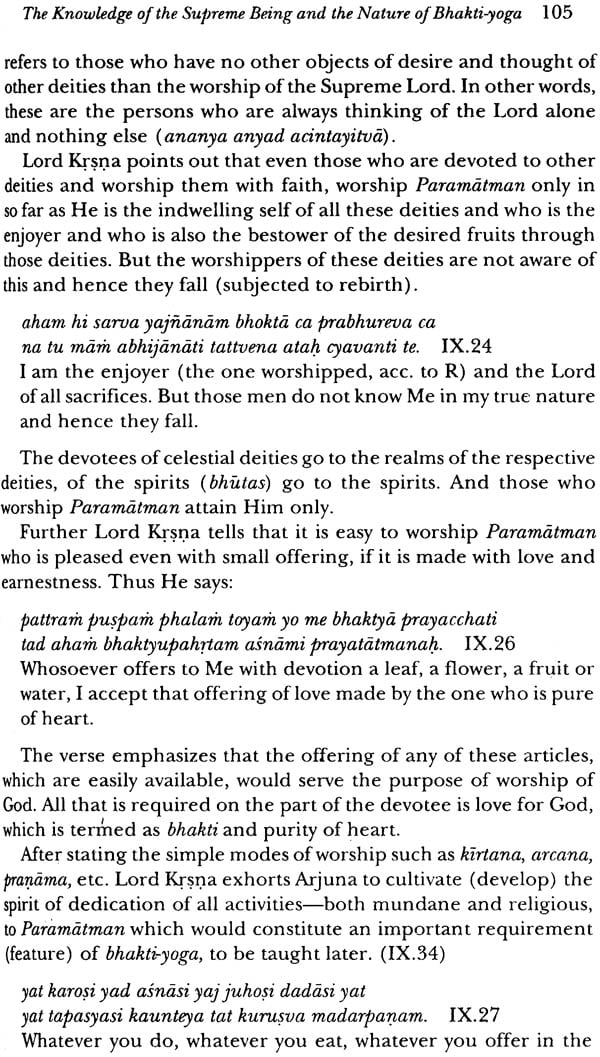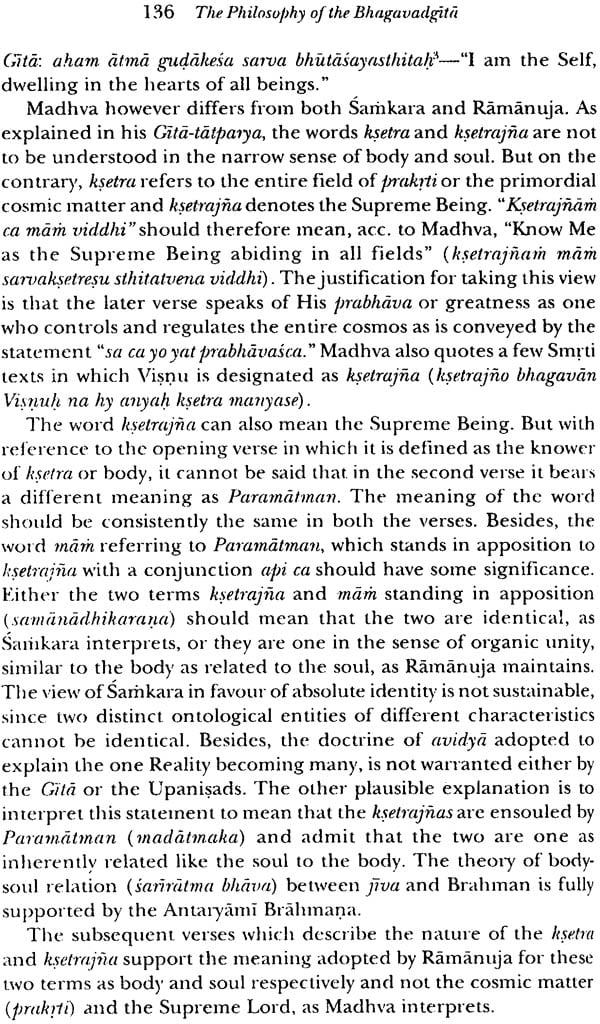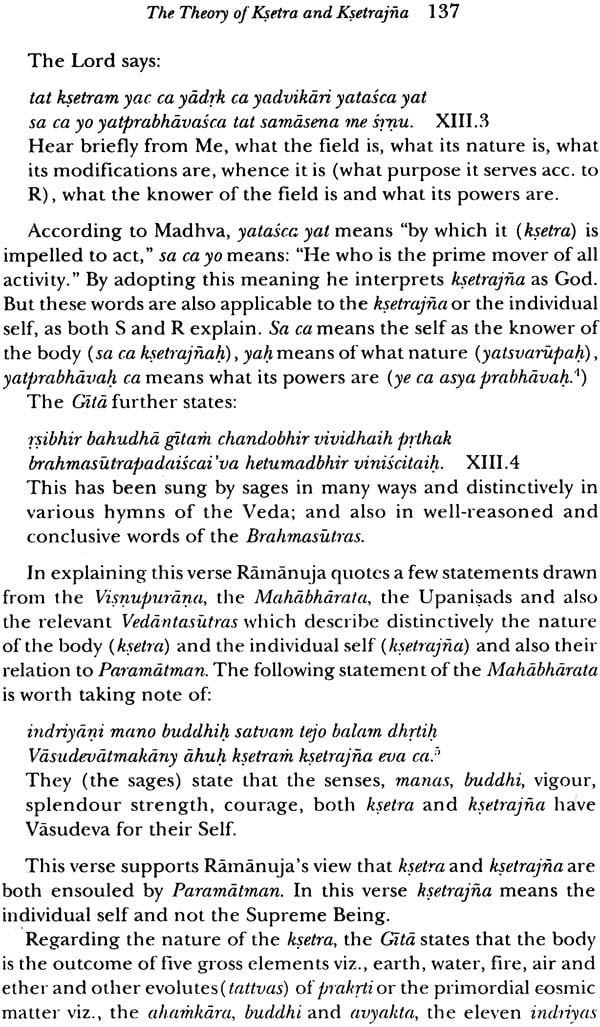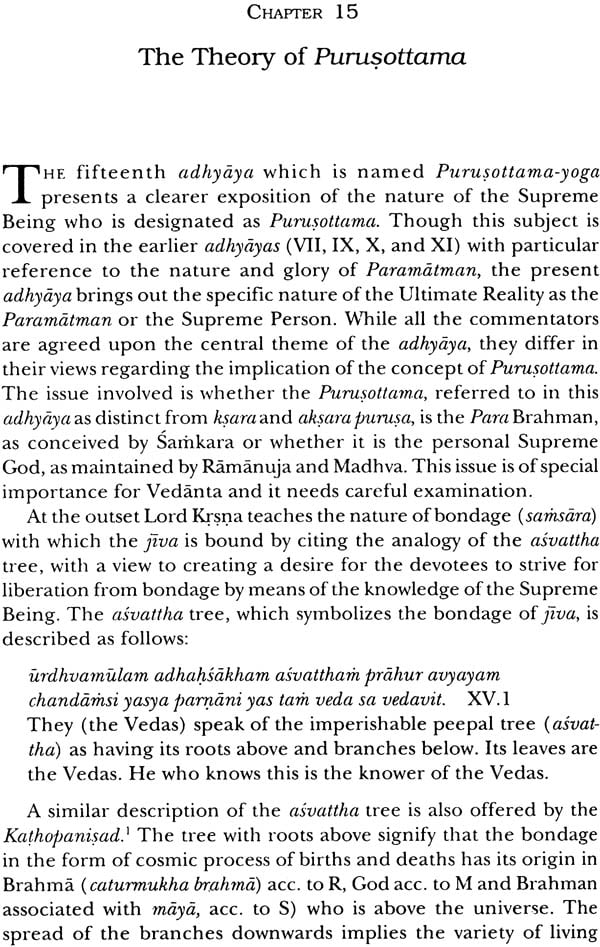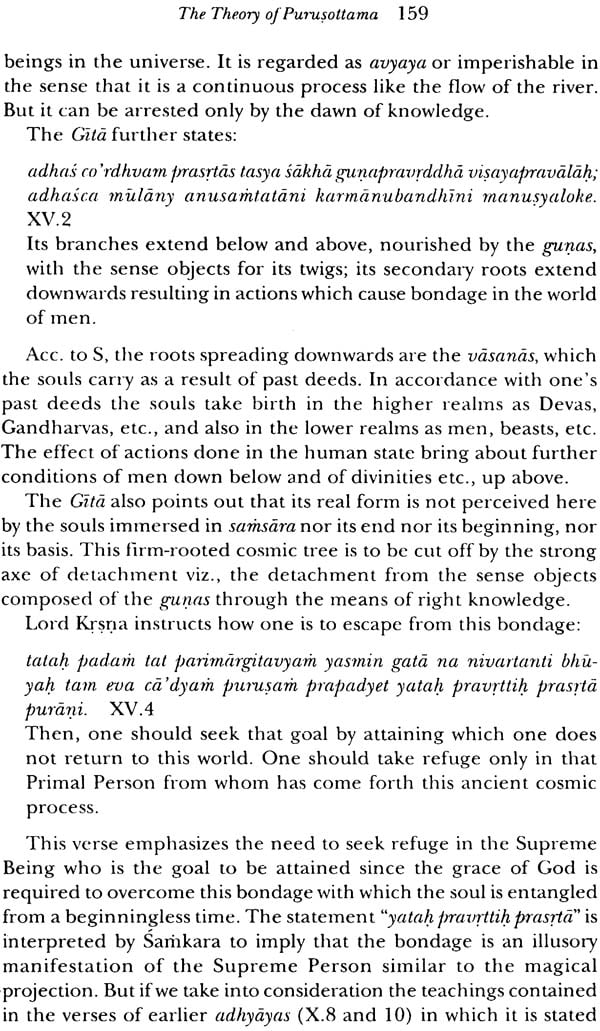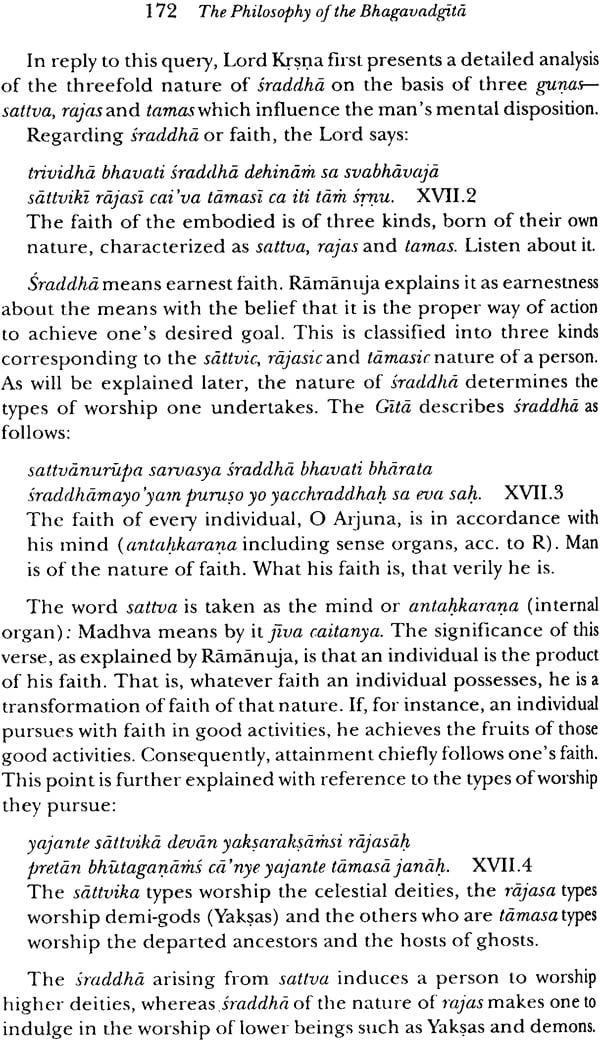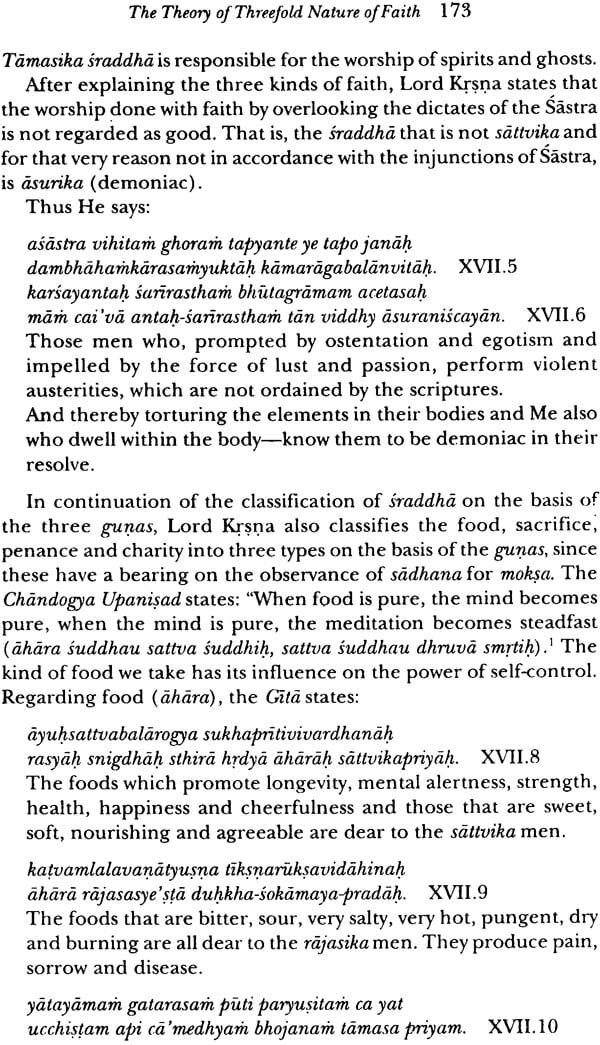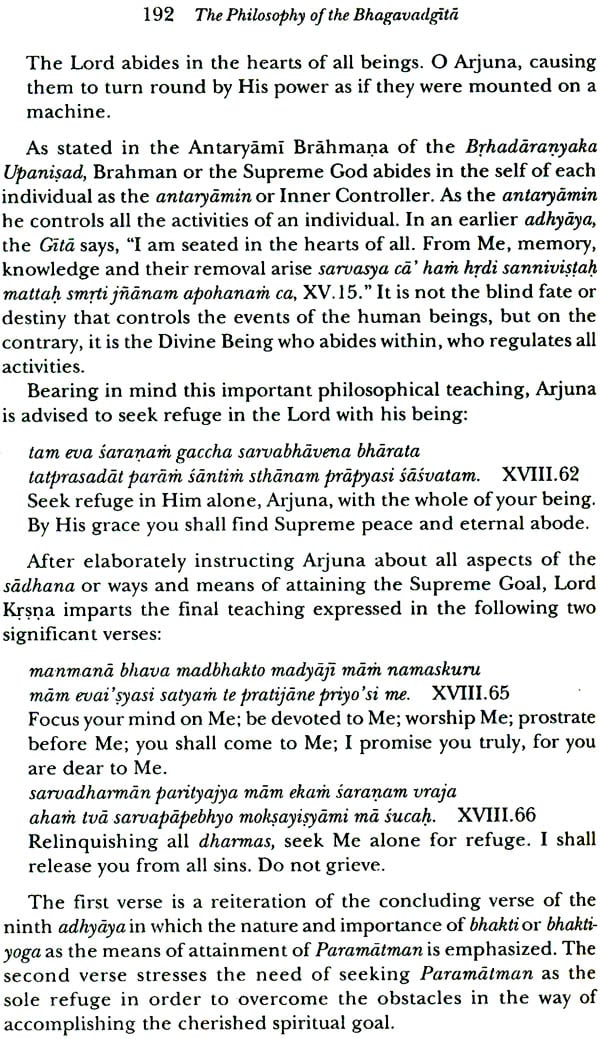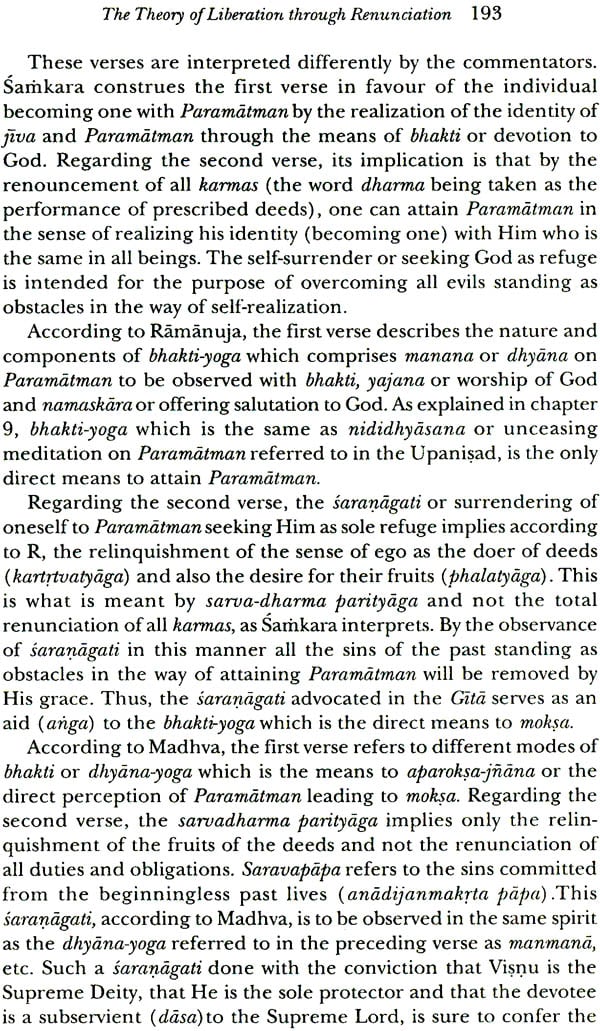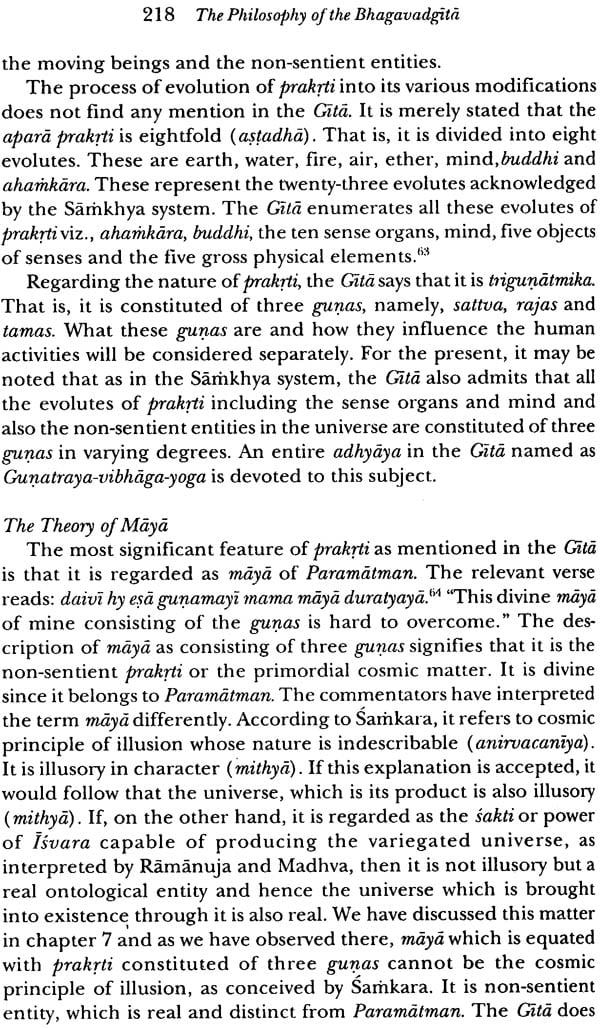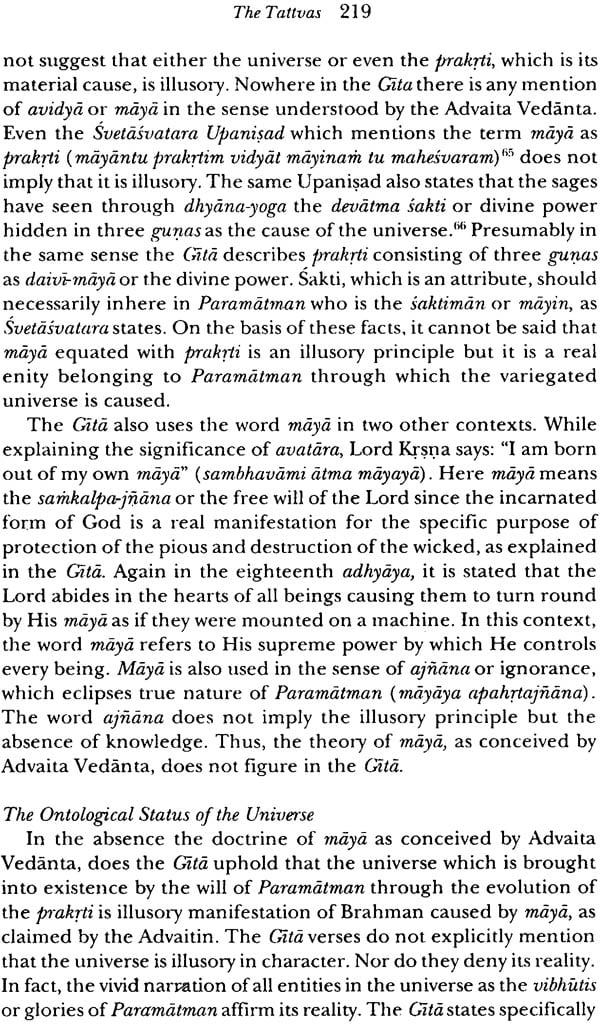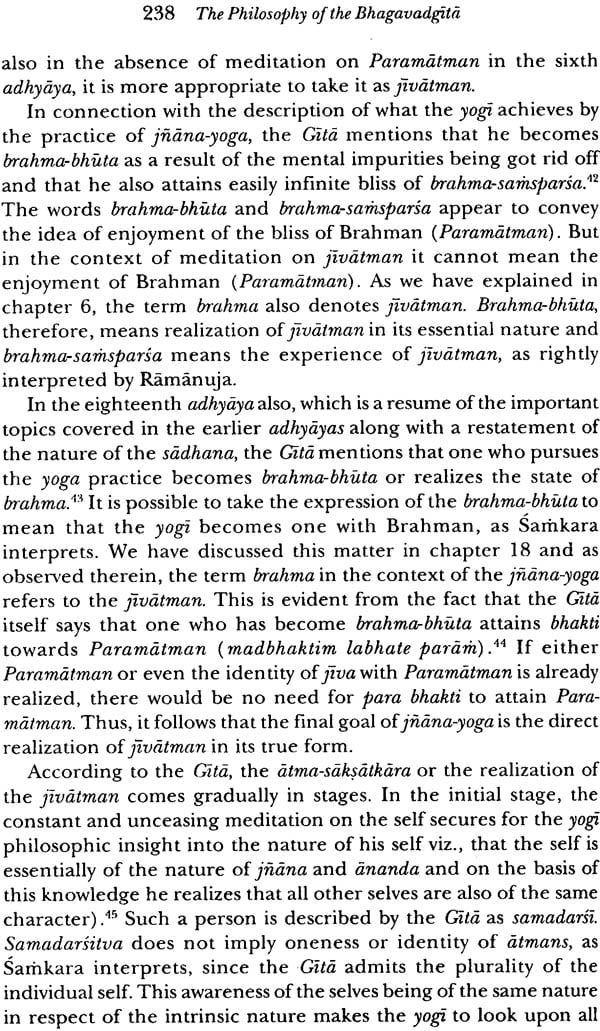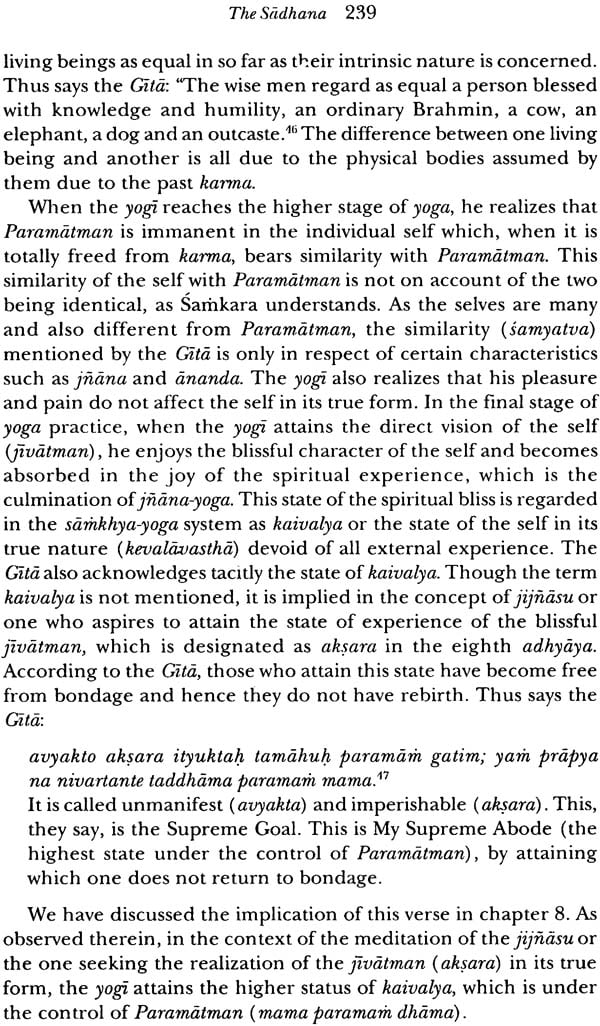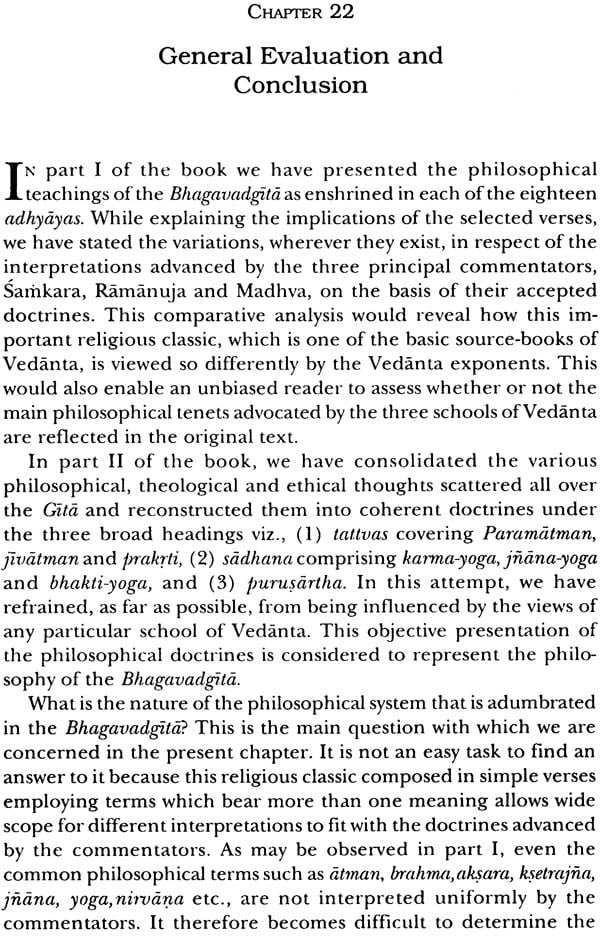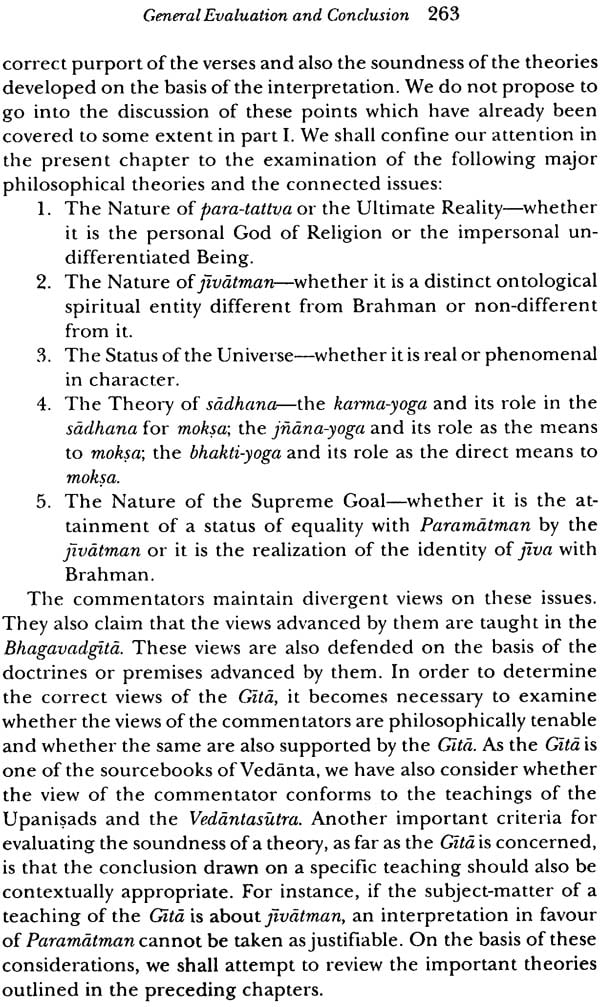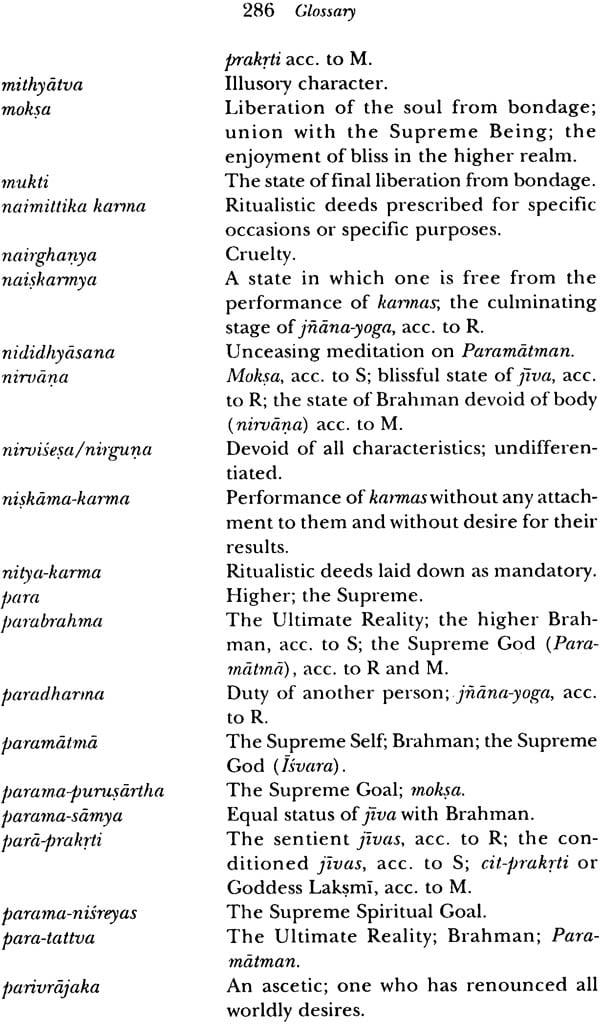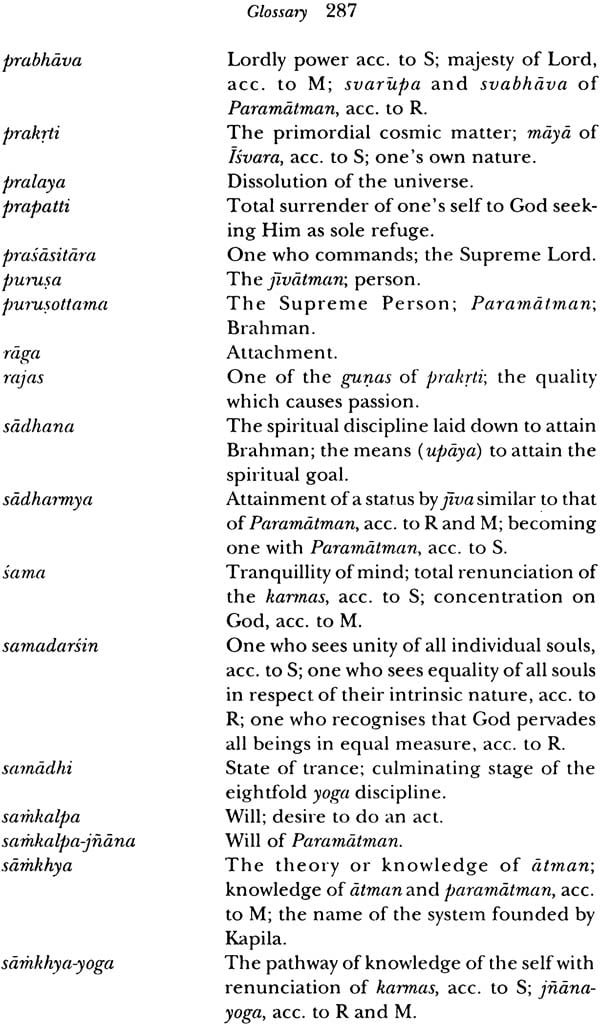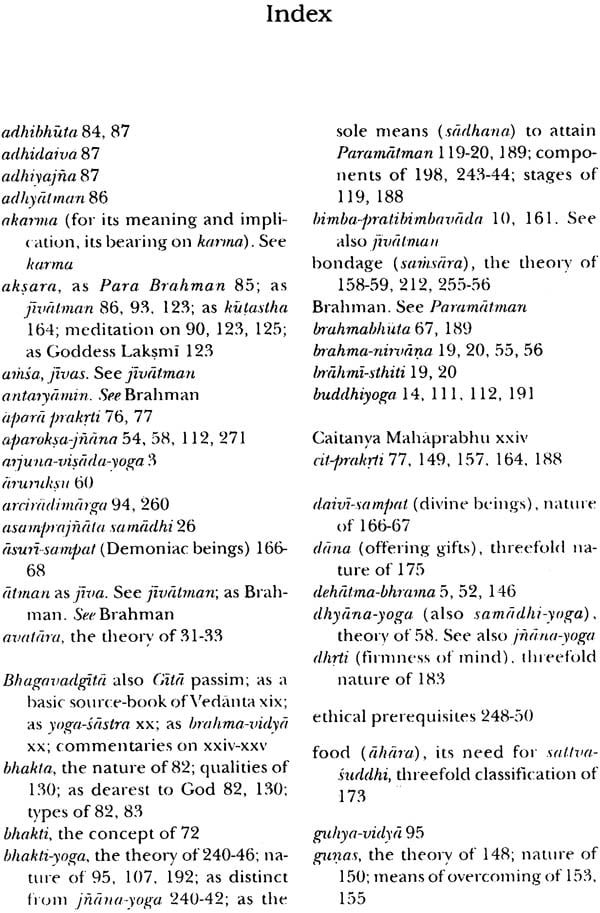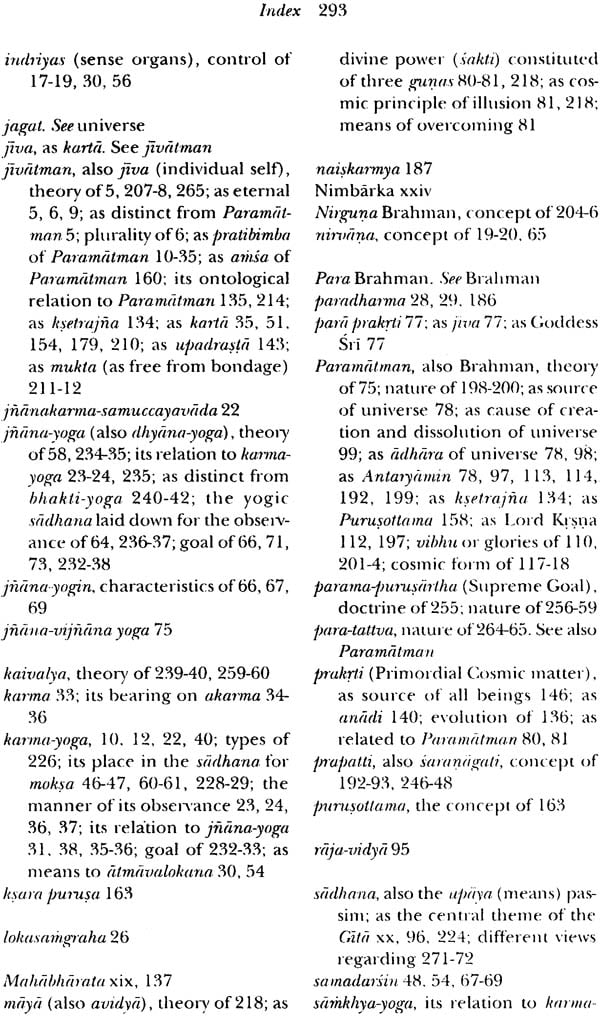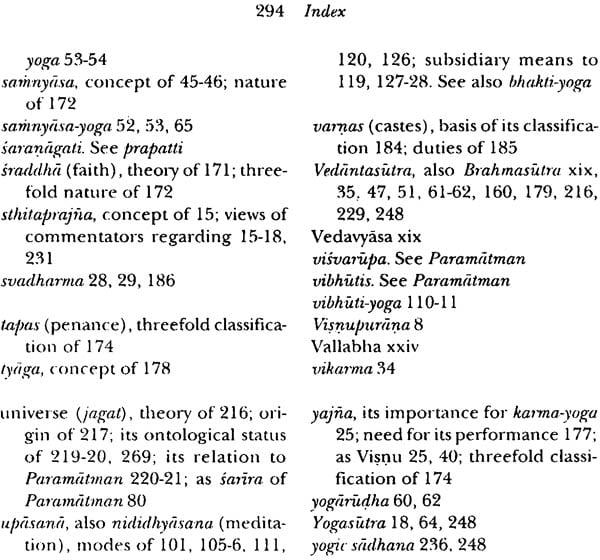
The Philosophy of the Bhagavadgita: A Study Based on the Evaluation of the Commentaries of Samkara, Ramanuja and Madhva
Book Specification
| Item Code: | IDE400 |
| Author: | S.M. Srinivasa Chari |
| Publisher: | MUNSHIRAM MANOHARLAL PUBLISHERS PVT LTD |
| Language: | English |
| Edition: | 2014 |
| ISBN: | 9788121511011 |
| Pages: | 320 |
| Cover: | Hardcover |
| Other Details | 8.8" X 5.8" |
| Weight | 540 gm |
Book Description
This scholarly work presents a comprehensive and authentic exposition of the philosophy of the Bhagavadgita as enshrined in the original text by according due consideration to the commentaries of Samkara, Ramanuja and Madhva. In the first part of the book, Dr. Chari makes an indepth study of the selected verses from each adhyaya and discusses their philosophical implications with particular reference to the Vedanta doctrines and connected issues advanced by the commentators while interpreting the crucial verses. This analytical and comparative study helps to understand how some of the basic tenets of Vedanta embedded in the Gita are explained differently by the commentators and also to assess the extent to which these are actually reflected in the original text. In the second part, the author has attempted to consolidate the various philosophical, theological and ethical ideas scattered all over the Gita and reconstruct them into coherent doctrines under three broad headings: Tattvas covering Paramatman, Jivatman and Jagat, Sadhana comprising Karma-Yoga, Jnana-yoga and Bhakti-yoga and Parama-purusartha. In the final chapter, Dr. Chari examines dispassionately the views of the commentators on these theories and comes to the conclusion with sufficient textual authority that some of the tenets of Samkara and also Madhva do not fully conform to the teachings of the Gita. This book, which is the first of its kind, throws new light on the philosophy of the Gita.
S.M. Srinivasa Chari is a Vedanta scholar trained up by eminent traditional teachers. He did his Ph.D. from University of Madras. His other published works are: Advaita and Visistadvaita - A study based on Vedanta Desika's Satadusani; Fundamentals of Visistadvaita Vedanta - A study based on Vedanta Desika's Tattva-mukta-kalapa; Vaisnavism - Its Philosophy, Theology and Religious Discipline; Philosophy and Theistic Mysticism of the Alvars; The Philosophy of the Vedantasutra; and The Philosophy of Upanisads - A study based on the Evaluation of the Commentaries of Samkara, Ramanuja and Madhva.
Foreword
The Bhagavadgita is universally acclaimed as the greatest religious classic. It is of special importance to the Vedantins as it contains lofty philosophical theories taught directly by Lord Krsna dealing with tattva or the ultimate Reality, hita or the means of its attainment and purusartha or the Supreme Spiritual Goal. All the great Acaryas have accepted the Gita as the basic sourcebook of Vedanta. They have also written scholarly commentaries on it. According to tradition, prior to Ramanuja, there were ninety-five commentaries on the Gita, the Ramanuja-bhasya being regarded as the ninety-sixth. There is also close affinity in respect of the philosophical teachings of the Gita and Brahmasutras. All the exponents of Vedanta have therefore sought support from the Gita for the doctrines advanced by them.
Among the extant commentaries on the Bhagavadgita, the bhasyas of Samkaracarya, Ramanujacarya and Madhvacarya stand out eminently. Though the three Acarya maintain divergent views regarding some of the main tenets of Vedanta such as the nature of Paramatman (para tattva), the nature of the individual self jivatman., the relation of jivatman to Paramatman in terms of non-difference (abheda) and difference (bheda), the nature of the Supreme goal and the nature of the direct means to moksa, they generally agree with regard to the central theme of the Gita viz., that Lord Krsna is the supreme Being (para tattva) and that He is to be sought as the Supreme Goal.
When we come to the details of the doctrines, we find wide differences in the views advanced by the commentators while interpreting the crucial verses. Throughout the Gita, Lord Krsna is conceived as the Supreme Being para tattva and there is no higher Reality than him. He is regarded as parama-brahma, as the sole cause of the creation and dissolution of the universe and also the supporter of it (adhara). but Samkara, while interpreting a few verses, brings up the theory of two forms of Brahman as para or higher, devoid of all determinations nirguna and apara or lower Brahman, associated with maya and endowed with attributes (saguna). No where in the Gita there is any mention of Nirguna Brahman or Brahman conditioned by maya.
Regarding the jivatman, the Gita explicitly states that it is eternal (nitya) and also different from Paramatman. it also accepts the plurality of the jives (jiva-bahutva). But Samkara advances the theory of identity of jiva and Brahman and explains the plurality of jivas on the basis of one Brahman being conditioned by the limiting adjuncts upadhi in the form of several antahkaranas caused by maya. But there is no support in the Gita for the doctrine of maya as conceived by Samkara nor for the theory that jivas are conditioned selves. Right from the beginning to the end, the Gita acknowledges the difference between jiva and Paramatman. The term sadharmya used to describe the status of jiva in the state of moksa implies the difference between jiva and Paramatman even after it is liberated from bondage. The observance of bhakti-yoga as the means of attainment of Paramatman necessarily presupposes the difference between the jiva as the upasaka and Paramatman as the object of attainment (upasya). The verse which describes Paramatman as the uttama-purusa, since He transcends both ksara-purusa and aksara-purusa clearly acknowledge the difference between the jivas and Paramatman.
The subject of sadhana constitutes the central doctrine of the Gita. From the teachings contained in the eleventh adhyaya, it is obvious that Bhakti or Bhakti-yoga is the sole means of attaining Paramatman (Bhaktya tu ananyaya sakyah). But Samkara, however, advances the theory that jnana is the sole means to moksa (kevaladeva tattva-jnanat moksa praptih). If we go by the order I which the teaching about sadhana is presented, the Gita in adhyayas II-IV advocates the observance of karma-yoga and jnana-yoga. in the adhyaya VII it introduces bhakti-yoga as the means to attain Paramatman. thus it follows that according to the Gita, bhakti-yoga as aided by karma-yoga and jnana-yoga is the direct means to moksa. Recognizing this fact, Ramanuja states at the very outset of his Gita-bhasya, that Lord Krsna under the pretext of persuading Arjuna to fight the war, introduced bhakti-yoga as aided by karma-yoga and jnana-yoga, which is enjoine din the Upanisads as the direct means to the Supreme Goal (pandutanaya yuddha protsahana vyajena parama-purusartha laksana sadhanataya vedantoditam svavisayam jnana-karmanugrhitam bhakti-yogam avatarayamasa).
Even Bhaskara and Yadava Prakasa, who came after Samkara, acknowledge that karma-yoga and jnana-yoga are aids to bhakti-yoga. But Samkara alters this order and advances the view that jnana-yoga is the sole means to moksa and that bhakti or bhakti-yoga leads to jnana in the sense of direct realization of the identity of jiva and Brahman (atmaikya-jnana). Madhva also does not admit that jnana-yoga taught in the VIth adhyaya is an aid to bhakti-yoga. According to him, jnana-yoga which is also named as dhyana-yoga. According to him, jnana-yoga which is also named as dhyana-yoga and samadhi-yoga, is not different from bhakti-yoga outlined in adhyayas IX-XII. The same dhyana-yoga pursued with Bhakti-yoga leading to aparoksa-jnana or direct perception of Paramatman by means of which moksa is attained.
There are several such important points relating to tattvas, sadhana and purusartha on which the commentators hold divergent views. Only a dispassionate study of the Bhagavadgita along with the views of Badarayana as expressed in the Vedantasutras and the Upanisads, would reveal the correct position regarding the philosophical theories enunciated in the Gita. Though there are innumerable books written in English on the Gita most of which follow the commentary of Samkara, there are very few authoritative works attempting to present a comprehensive account of the philosophy of the Bhagavadgita based on an objective evaluation of the views of the three commentators.
It is highly commendable that Dr. S. M. Srinivasa Chari, who is a distinguished scholar, has undertaken an in-depth study of the Gita by examining dispassionately all the three bhasyas. In the first part of the book, he has judiciously selected the verses from each adhyaya bearing on the Vedanta doctrines and discussed their philosophical significance with reference to the divergent views advanced by the commentators. In the second part, he has attempted to consolidate the various thoughts scattered all over the Gita and reconstruct them into coherent doctrines under the broad headings viz., tattvas, sadhana and parama-purusartha. as one well trained by eminent traditional Acaryas and with his knowledge of the Upanisads and the Vedantasutras, as evidenced by his two scholarly books on this subject, he has ably presented an authentic and comprehensive exposition of the philosophy of the Bhagavadgita, this is undoubtedly an authoritative and scholarly work written for the first time in English. It will definitely throw new light on the philosophy of the Gita and will be very useful for a comparative study of Vedanta.
Preface
The Bhagavadgita is acknowledged by all Vedantins as one of the three sourcebooks of the Vedanta system of philosophy, the other two being the Upanisads and the Brahmasutras of Badarayana. It is accepted as a philosophical work devoted primarily to teach the fundamental doctrines of Vedanta viz., tattva or the ultimate Reality. Sadhana or the means of its realization and purusartha or the Supreme Goal. My earlier books on the Upanisads and the Vedantasutra based on an objective evaluation of the comments of Samkara, Ramanuja and Madhva have attempted to show that the main tenets of Advaita Vedanta are not reflected in these two basic sourcebooks. The present work attempts to make a similar study of the Bhagavadgita, with a view to determine the nature of the philosophical doctrines adumbrated in the verses of the Gita.
There is extensive literature on the Bhagavadgita contributed by eminent scholars both in India and abroad. Most of these are in the form of translations into English and other languages with notes, while some are expository. The present work is not intended to duplicate this kind of effort. Its scope is restricted to discuss selected verses of the Gita having a bearing on the philosophical theories, by according due consideration to the views of the three principal commentators as well as the teachings of the Upanisads and the Vedantasutra and present a consolidated and comprehensive exposition of the philosophy of the Gita. It is hoped that this book which is the first of its kind will throw new light on the philosophy of the Bhagavadgita.
In the preparation of this book, I have drawn material mostly from the original texts-the three basic commentaries on the Bhagavadgita by Samkara, Ramanuja and Madhva, along with the Tatparya-candrika of Vedanta Desika (commentary on Ramanuja-bhasya), Gita-tatparya of Madhvacarya and Prameya-dipika of Jayatirtha (commentary on Madhva-bhasya). In the matter of rendering of the verses into English and explaining their significance in accordance with the respective schools of Vedanta, I have made use of the following books: Dr. S. Radhakrishnan, The Bhagavadgita, Swami Adidevananda, Ramanuja Gita-bhasya and Dr. B. N. K. Sharma, The Bhagavadgita-bhasya of Madhvacarya. I acknowledge my indebtedness to these authors.
I must pay my respects to my revered Acarya, the late Gostipuram Sowmyanarayanacarya Swami to whom I owe my knowledge of Vedanta. I must also pay my respects to the late Sri Puttankottai Srinivasacharya Swami and Sri Saragur Varadacharya Swami under whom I studied the Gita-bhasya in the traditional style. I have derived help and guidance for understanding the crucial verses of the Gita from the traditional scholars, Sri K. S. Varadacharya, Sri N. S. Ramanuja Tatacharya, Sri K. T. Pandurangi and Sri A. Haridasa Bhatta. I should also thanks Dr. N. S. Anantharangachar, the late Sri S. M. Krishnamachar, Sri S.K. Ramachandra Rao and Sri S. Srinivasachar, who have gone through the major part of the typescript and offered suggestions for improvement. My thanks are also due to all those who have helped me in one way or the other and in particular, to my wife and other family members without whose loving cooperation I would not have completed this book in my advanced age. I also express my grateful thanks to the eminent Sanskrit scholar, Sri Srivatsankacharya for writing a Foreword to this book.
THE Bhagavadgita, popularly known as Gita or the "Divine Song," is universally acclaimed as a distinctive religious classic. Its teachings have attracted the attention of many people across the world. Though it constitutes a part of the Mahabharata, the celebrated Hindu epic compiled by sage Vedavyasa, it enjoys the status of an independent philosophical treatise. In fact the Gita is one of the three basic source books for the Vedanta system of philosophy, the other two being the Upanisads and the vedantasutra of Badarayana. The Upanisads which are regarded as Vedanta, being the culminating part of the Vedas, contain the lofty philosophical teachings. The Vedantasutra codifies these teachings in the form of cryptic aphorisms. The Bhagavadgita elucidates the same teachings in the form of a versified dialogue between Lord Krsna and Arjuna. While the Upanisads as part of the Vedas enjoy the status of the Revealed Scripture (Sruti) , the Vedantasutra and the Gita are accorded the status of smrti or that which is based on sruti and also that which elucidates what is taught in the Vedas.
According to the traditional exponents of Vedanta, there is perfect conformity between the three works. The Gita itself in one of its verses mentions that the Brahmasutrasdetermine the purport of the crucial Upanisadic texts by adopting logical arguments. It also refers in a number of places to the Upanisadic texts." Badarayana often refers to the Gita as smrti text in support of the theories advanced in the Vedantasiura According to the traditional view, the same Vyasa who is the compiler of Mahabharata in which the Bhagavadgita is included, is also the author of the Vedantasutra. A popular verse extolling the greatness of the Bhagavadgita compares the Upanisads to the cow, the Gita to the milk drawn from it by the cowherd Gopala (Krsna), Arjuna to the calf and the men of wisdom to those who savour the nectar of the Gita.
Of the three basic classics of the Vedanta, tradition accords greater importance to the Bhagavadgita since the teachings contained in it are imparted directly by Lord Krsna to Arjuna. As the colophon at the end of each adhyaya indicates, it is called Upanisad, since it derives its thoughts from the Upanisads. It is regarded as brahma-vidya, since it is a treatise imparting the knowledge of Brahman. It is also characterized as yoga-sustra, since it expounds in detail the sadhana to be pursued for attaining the Supreme Being."
According to the commonly accepted view, the Gita comprises 700 verses. However, one of the editions, which is claimed to belong to pre-Samkara times, puts it as 745 verses. But on careful scrutiny it is found that the additional verses do not add anything new to what is mentioned in the other editions. Samkara explicitly states in his bhhasya on the Gita that Vedavyasa compiled the teachings of Lord Krsna to Arjuna in 700 verses." This view is endorsed both by Ramanuja and Madhva.
The Gita is divided into 18 adhyayas or chapters. Each deals with a major topic or theme as indicated in the colophon. The 18 adhyayas are further subdivided in to three parts known as satkas or hexads, each one covering six adhyayas. As will be seen in the next chapter, there is no unanimity among the commentators regarding the subject-matter of each adhyaya and also of the hexads.
Regarding the central theme of the Bhagavadgita, there is some difference of opinion among the three principal commentators. According to Samkara, the main objective of the Gita-sastra, as explained in the preface to his bhasya, is to teach the pravrtti-dharma and nivrtti-dharma, which is the means to the attainment of the Supreme Spiritual Goal. Pravttti-dharma means for Samkara, the performance of the prescribed Vedic deeds by dedicating them to the Supreme Being without any desire for fruits. The nivrtti-dharma involves renunciation of all deeds (karma). The former secures purity of the mind (sattva-suddhi) and the steadfastness in the knowledge of atman (jnana-nisthata), which in turn serves as the direct means to the final liberation. Thus, the central theme of the Gita-sastra is to teach the ways and means of attaining liberation from bondage, which is the Supreme Spiritual Goal (parama- nisreyas).
According to Ramanuja, the main theme of the Gita-sastra is the advocacy of bhakti-yoga as the direct means to the Supreme Goal. In a characteristic way, he states in the preface to his Gita-bhasya, that Lord Krsna, under the pretext of persuading Arjuna to fight the war, introduced bhakti-yoga, as aided by karma-yoga and jnana- yoga, which is enjoined in the Upanisads as the direct means to the Supreme Goal.
Madhva, in his preface to the Gita-bhasya, emphasises the importance of the Mahabharata as a work presented by Vyasa, who is himself an incarnation of Lord Visnu and who taught the path of duty and knowledge for the benefit of deserving individuals who had lost sight of nivrtti-dharma and jnana. Into such a work, he included the Gita in the form of a dialogue between Vasudeva and Arjuna epitomising the message of the whole epic. The Gita, which contains the essence of the entire Mahabharata, is helpful to overcome bondage and attain the Supreme Being.
Though there are differences in the matter of details regarding the main objective of the Gita-sastra, it is agreed by all the com- mentators that the teachings of the Gita are primarily directed towards the sadhana or the means of the attainment of the Supreme Goal. In other words, the main theme of the Gita is sadhana for moksa or liberation from bondage.
As a philosophical treatise constituting the basic sourcebook of Vedanta, it also deals with the other two important doctrines of Vedanta viz., tattva or the Ultimate Reality and purusartha or the Supreme Goal. As allied to the doctrine of tattva, the Gita covers the theories of jivatman and the cosmic universe (jagat). As related to the sddhana, it also deals extensively with ethical and religious pre-requisites.
While the commentators generally agree with regard to the broad subject-matter covered in the Bhagavadgita, they widely differ with regard to the nature of the doctrines. These differences can be conspicuously noticed in respect of the sudhana prescribed for the attainment of the Supreme Goal, which is the central theme of the Gita. The Gitarefers to karma-yoga, jnana-yoga also known as dhyana- yoga and bhakti-yoga as the means to moksa. While adhyayas II-VI primarily deal with karma-yoga and jnana-yoga, the adhyayas VII-XII are devoted to the teaching of the bhakti-yoga. An important issue which arises in this regard is: of these prescribed pathways, which one is the principal means and which one is the subordinate means. According to Samkara, jaana-yoga understood as the direct realisation of the true nature of the Self (atman) which is the same as Brahman, is the direct means to moksa. Ramanuja considers that the bhakti-yoga or the unceasing loving meditation on the Paramdtman as enunciated in the adhyayas VII-XII is the direct means to moksa, whereas karma-yoga and jnana-yoga understood as the realization of the true nature of the jivatman (jivatma-saksatkara) are subsidiary means (anga) to bhakti-yoga. Madhva advances a different view. The karma-yoga understood as the performance of the prescribed karmas or deeds without any desire for the results (niskama karmanusthana) along with jnana or the knowledge of the true nature of the jivatman and the Paramatman leads to bhakti-yoga which is termed as Paramatma-dbyana or meditation on Paramatman. Such a dhyana secures for the upasaka the vision of God (aparoksa jnana) and this serves as the direct means to moksa.
Another important theory on which the commentators widely differ is about the nature of the jivatman in relation to Paramatman. In the second adhyaya, the Gita teaches the nature of jivatman as distinct from the perishable physical body. It also describes in the later adhyayas about the nature of Paramatman who is conceived as Lord Krsna, also named as Vasudeva, and who is the creator, protector and controller of the universe. An important issue which arises in this connection is: whether Paramatman referred to in the Gita is the Para Brahman of the Upanisads or is he the Apara Brahman, or Brahman associated with maya, as conceived by Samkara. According to Ramanuja and Madhva, the Paramatman referred to in the Gita is the same Para Brahman of the Upanisads, whereas for Samkara, the theistic God in the name of Krsna or Vasudeva is the lower Brahman (apara brahma).
More importantly, the relation of jivatman to Paramatman has assumed great controversy. The issue which is raised in this regard is: whether jivatman and Paramatman. (Brahman) are two distinct real ontological entities or whether jiva is essentially the same as Brahman. Samkara maintains the latter view, whereas Ramanuja and Madhva subscribe to the former.
| Foreword | xi |
| Preface | xv |
| Abbreviations | xvii |
| Introduction | xix |
| PART I The Philosophical Teachings of the Bhagavadgita | 1 |
| Chapter 1 The Despondency of Arjuna and the Initiation of the Gita | 3 |
| Chapter 2 The Theory of Ataman and the Theory of Yoga | 5 |
| Chapter 3 The Theory of Karma-yoga | 22 |
| Chapter 4 Karma-yoga and its Relation to Jnana-yoga | 31 |
| Chapter 5 The Theory of Samnyasa-yoga | 44 |
| Chapter 6 The Theory of Dhyana-yoga | 58 |
| Chapter 7 The Theory of Paramatman | 75 |
| Chapter 8 The Theory of Meditation on Aksara-brahma | 85 |
| Chapter 9 The Knowledge of the Supreme Being and the Nature of Bhakti-yoga | 95 |
| Chapter 10 The Theory of God and His Glory | 110 |
| Chapter 11 The Cosmic Form of God | 116 |
| Chapter 12 The Theory of Bhakti-yoga | 122 |
| Chapter 13 The Theory of Ksetra and Ksetrajna | 133 |
| Chapter 14 The Theory of the Three Gunas | 148 |
| Chapter 15 The Theory of Purusottama | 158 |
| Chapter 16 The Nature of Divine and Demoniac Beings | 166 |
| Chapter 17 The Theory of Threefold Nature of Faith | 171 |
| Chapter 18 The Theory of Liberation through Renunciation | 177 |
| PART II The Philosophical Doctrines of the Bhagavadgita | 198 |
| Chapter 19 The Tattvas
| 197 |
| Chapter 20 The Sadhana
| 224 |
| Chapter 21 The Doctrine of Parama-purusartha | 255 |
| Chapter 22 General Evaluation and Conclusion
| 262 |
| Glossary | 281 |
| Bibliography | 290 |
| Index | 292 |
